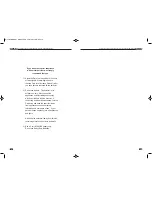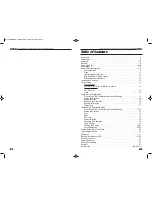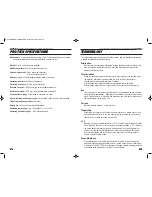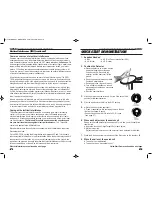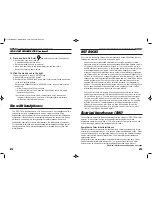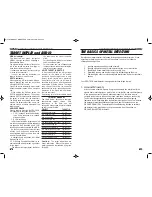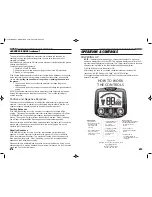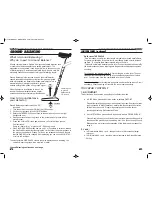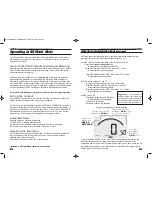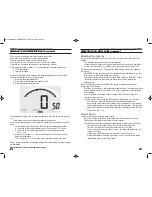
29
Comprehensive Operating Manual & Guide to Metal Detecting
PRO-TECH
Electrical Interference (EMI) (continued)
If you are conducting an indoor demonstration, you may find that changing the
orientation of the searchcoil will reduce the pickup of electrical interference.
If you carry a cell phone or other high-tech electronic equipment while metal
detecting and you encounter electrical interference, try turning the device off and see
if that solves the problem. Turn such devices completely off, not just into standby
mode.
When working near overhead power lines, you may get the best results right under
the power line and the worst results when standing at a 30° to 45° angle to the
power line.
Many sources of electrical interference are intermittent. You may find that an area
which is difficult to search at one time of day may be easier after 5 PM, or on
weekends. Power lines are usually quietest late at night, and on weekend mornings.
Small searchcoils usually pick up less electrical interference than larger searchcoils.
On a site with severe electrical interference, a small searchcoil is often a better
choice than a large one.
Distinguishing electrical interference from other problems
Electrical interference will often vary as you walk around from place to place, and it
will also vary with changes in the orientation of the searchcoil. This is almost never
the case if there is a functional problem with the metal detector itself.
The most common cause of a noisy metal detector, where the problem is not
electrical interference, is a defective searchcoil. If striking the searchcoil with your
hand causes the noise to start or stop, the problem could be a defective searchcoil.
Also, a defective searchcoil often causes noise of a more intermittent nature than
electrical interference.
The second most common cause is a loose searchcoil connector. The noise from a
loose connector will usually be very erratic or intermittent in nature. Try unplugging
the searchcoil and then reconnecting it to ensure the connector is firmly installed.
If you use a searchcoil cover, dirt or water can accumulate inside it, and movement
of those materials can cause false signals while sweeping the searchcoil. Searchcoil
covers must be periodically removed and cleaned.
8
PRO-TECH
Comprehensive Operating Manual & Guide to Metal Detecting
BATTERIES
A 3-segment battery indicator at the bottom of the display indicates the battery
condition.
The detector requires a single 9-volt
ALKALINE
battery (included).
Do not use ordinary zinc carbon batteries.
Do not use “Heavy Duty” batteries.
Rechargeable batteries can also be used.
If you wish to use rechargeable batteries, we recommend using a
Nickel Metal Hydride rechargeable battery.
The battery compartment is located on the back side of the housing.
Slide the battery door to the side and remove it to expose the battery compartment.
Battery Life
Expect about 15 to 20 hours of life from a 9-volt alkaline battery.
Rechargeable batteries can provide up to 8 hours of usage per charge.
Speaker Volume and Battery Charge
You may notice the speaker volume drop when only one battery segment is
illuminated.
With one segment flashing, low speaker volume will be very apparent.
Battery Indicator
The 3-segment battery indicator has 4 stages of indication.
These indications are accurate for a 9-volt alkaline battery.
Segments Illuminated
Battery Voltage
3 -segments
more than 8.4 volts
2 -segments
more than 7.5 volts
1 -segment
more than 6.8 volts
1 -segment flashing
less than 6.8 volts
After the 1st segment begins flashing, expect the detector to shut off within 10
minutes.
A rechargeable battery will usually illuminate two to three segments throughout most
of its useful charge. But as soon as it drains to the 1-segment level, it will then lose
its charge very rapidly.
BATTERY DISPOSAL & RECYCLING
Alkaline batteries may be disposed of in a normal waste receptacle or recycled. Non-
Alkaline batteries should be recycled. In the state of California all battery types must
be recycled. Please refer to local municipalities for detailed disposal and recycling
requirements.
ProTechMANUAL_MPROTECH 1/28/15 8:14 AM Page 16


